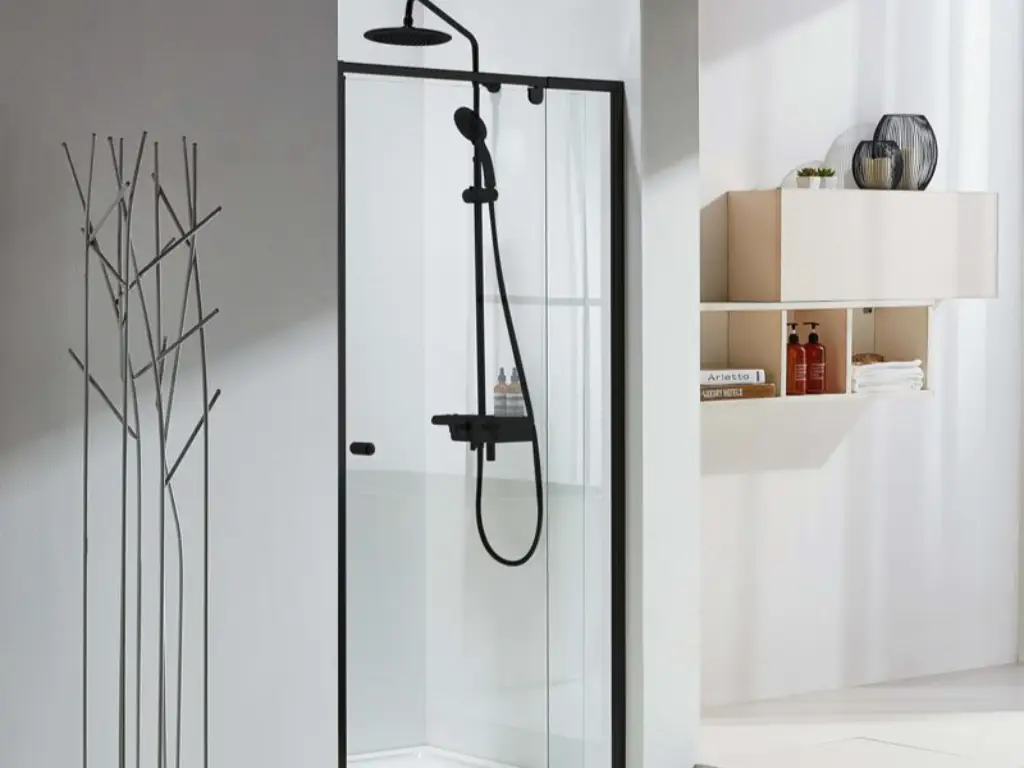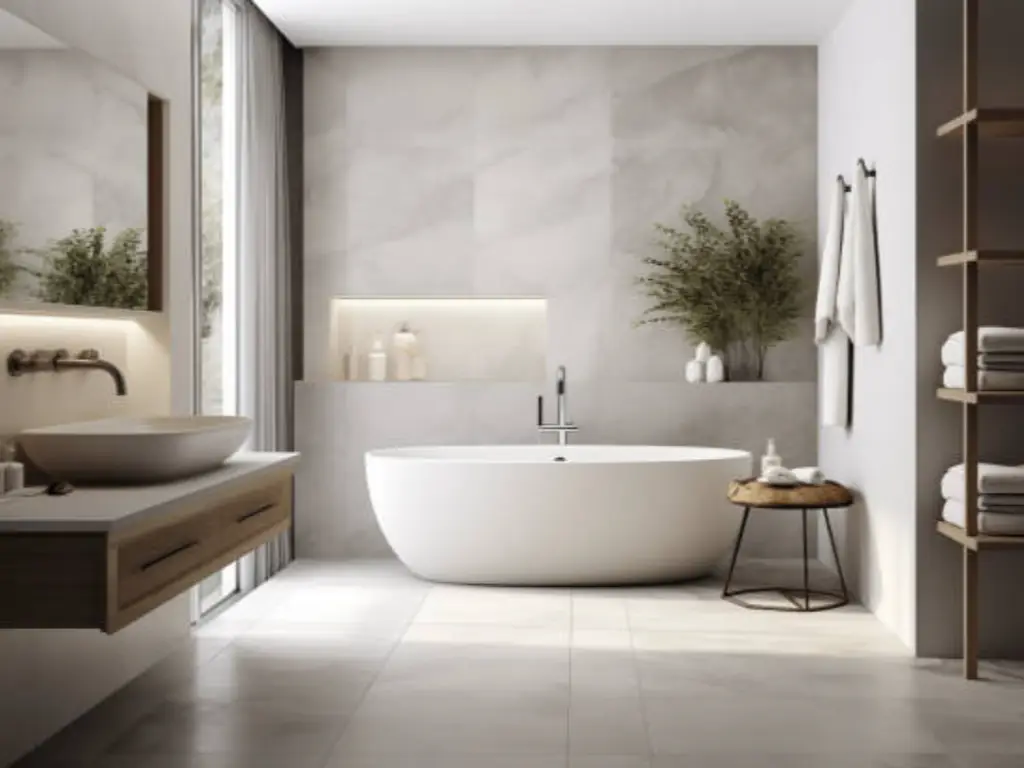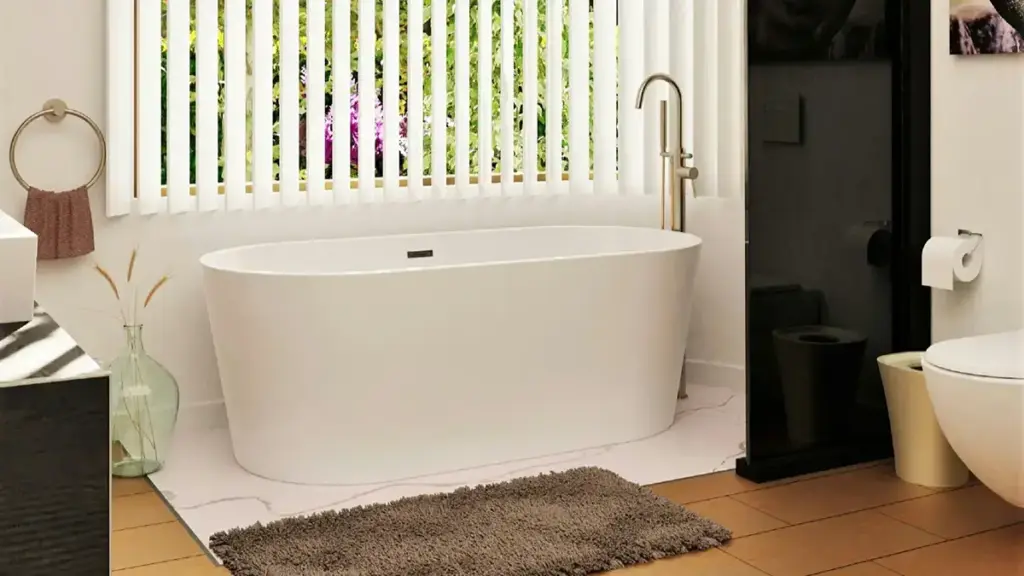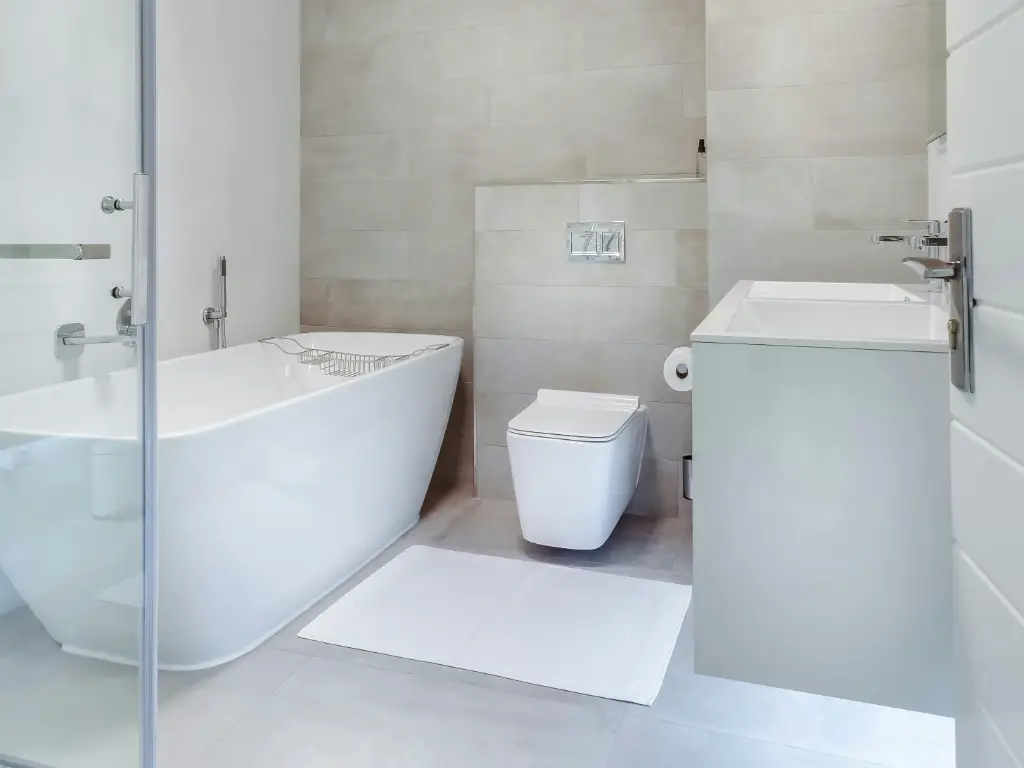Un bagno caldo in una fredda mattina è un gradito lusso. I portasciugamani riscaldati portano calore e comfort, mantenendo gli asciugamani comodi e riducendo l'umidità nell'aria. Ma possono fare di più che semplicemente tenere caldi gli asciugamani?? Molte persone si chiedono se un portasciugamani riscaldato sia abbastanza potente da riscaldare un intero bagno. In questo articolo, esploreremo le capacità di riscaldamento dei portasciugamani, esaminando quali fattori influenzano la loro efficienza e quali tipi funzionano meglio in spazi più piccoli.
Cos'è un portasciugamani riscaldato?

Un portasciugamani riscaldato, noto anche come scaldasalviette, è un sanitario progettato per mantenere gli asciugamani caldi e asciutti. Solitamente è costituito da una struttura metallica con barre o pannelli che emettono calore, sia attraverso sistemi elettrici che idronici. I portasciugamani elettrici si collegano a una presa, mentre quelli idronici si collegano al riscaldamento centralizzato. Oltre agli asciugamani riscaldanti, possono aggiungere un po' di calore all'aria circostante.
Un portasciugamani riscaldato può riscaldare un bagno da solo??
La questione se un portasciugamani possa riscaldare un intero bagno dipende da alcuni fattori. I bagni più piccoli potrebbero infatti risultare più caldi con un portasciugamani riscaldato, ma i bagni più grandi potrebbero richiedere un riscaldamento aggiuntivo.
Situazioni in cui un portasciugamani può riscaldare un piccolo bagno
Per bagni compatti, un portasciugamani ad alto rendimento può essere sufficiente per mantenere una temperatura confortevole. Piccolo, i bagni ben isolati tendono a trattenere il calore generato dalla ringhiera, il che significa che lo spazio può rimanere accogliente senza una fonte di calore secondaria.
Dimensioni ideali del bagno per il riscaldamento autonomo con portasciugamani
Generalmente, I portasciugamani funzionano meglio come fonti di calore primarie nei bagni Sotto 40 piedi quadrati. In questi spazi, la resa termica di un portasciugamani di qualità può essere sufficiente, soprattutto se il bagno è isolato. Per bagni medi o grandi, Tuttavia, un portasciugamani può funzionare meglio come fonte di calore supplementare piuttosto che come fonte principale.
Come i portasciugamani riscaldati generano calore?
I portasciugamani riscaldati funzionano emettendo calore radiante o convettivo. I modelli elettrici spesso contengono elementi riscaldanti che riscaldano il metallo, mentre i modelli idronici fanno circolare l'acqua calda per generare calore. Il telaio metallico irradia quindi calore, riscaldando sia gli asciugamani che l'aria vicina. Il calore si estende dal binario stesso e si irradia verso l'esterno, contribuendo a mantenere il bagno accogliente.
Tipi di portasciugamani riscaldati
I portasciugamani riscaldati sono progettati in diversi tipi per soddisfare le diverse esigenze di riscaldamento e preferenze di installazione. Ogni tipologia offre vantaggi unici a seconda che tu abbia bisogno del riscaldamento completo del bagno o semplicemente desideri asciugamani caldi pronti in qualsiasi momento.
Portasciugamani elettrici
I portasciugamani elettrici funzionano indipendentemente dal sistema di riscaldamento centralizzato della tua casa. Si collegano direttamente a una presa elettrica o sono cablati, rendendoli facili da installare e versatili nel posizionamento. Ideale per le case in cui il riscaldamento centralizzato non è sempre acceso, gli scaldasalviette elettrici per il bagno possono essere utilizzati tutto l'anno, e molti sono dotati di timer e termostati per una maggiore efficienza energetica.
Portasciugamani idronici
Questi si collegano direttamente al sistema di riscaldamento centralizzato a base acqua della tua casa. Le guide idroniche si riscaldano quando il riscaldamento centralizzato è in funzione, rendendoli efficienti dal punto di vista energetico ed economici, soprattutto nei mesi più freddi. Tuttavia, sono operativi solo quando il riscaldamento centralizzato è acceso, che possono limitarne l'uso nei mesi più caldi a meno che non siano abbinati a un sistema a doppia alimentazione.
Portasciugamani a doppia alimentazione
I portasciugamani a doppia alimentazione combinano il meglio dei sistemi elettrico e idronico, consentendo flessibilità tutto l'anno. Si collegano al sistema di riscaldamento centralizzato ma includono anche un elemento riscaldante elettrico. Questa doppia funzionalità significa che possono funzionare in modo indipendente durante i mesi più caldi quando il riscaldamento centralizzato è spento, fornire asciugamani riscaldati e calore extra in bagno senza riscaldare l'intera casa.
Ciascuna tipologia offre diversi vantaggi in termini di riscaldamento ed efficienza energetica, quindi la scelta giusta dipende dal tuo stile di vita, il clima, e quanto controllo è necessario sul riscaldamento del bagno durante tutto l'anno.
Fattori che influenzano l'efficacia del riscaldamento
Diversi fattori determinano se un portasciugamani riscaldato può riscaldare efficacemente un bagno.

Dimensioni della stanza e isolamento
Le dimensioni del tuo bagno e il suo livello di isolamento giocano un ruolo significativo. In un ambiente ben isolato, bagno più piccolo, il calore proveniente da un portasciugamani può essere più contenuto, massimizzandone l’efficacia. Bagni più grandi, d'altra parte, disperdere il calore più velocemente, quindi il solo calore di un portasciugamani potrebbe sembrare insufficiente.
Potenza termica e valori BTU
BTU, o Unità Termica Britannica, misura la potenza riscaldante di un dispositivo. Per termoarredo, un valore BTU più alto significa una maggiore capacità di riscaldare l'ambiente. Scegliere un portasciugamani con la BTU adeguata alle dimensioni del proprio bagno è essenziale. Ad esempio, potrebbe bastare un piccolo bagno 500-800 BTU, mentre spazi più ampi richiedono 1,000 BTU o più.
Posizionamento del portasciugamani
Il posizionamento è fondamentale. Installazione del portasciugamani vicino all'area principale di attività, ad esempio vicino alla doccia, aiuta a distribuire il calore in modo efficace. Una posizione centrale può garantire una migliore diffusione del calore in tutta la stanza, migliorandone l’efficienza complessiva.
Vantaggi dell'utilizzo di un portasciugamani riscaldato
I portasciugamani riscaldati offrono numerosi vantaggi che vanno oltre il semplice riscaldamento degli asciugamani.
Fornisce calore agli asciugamani e alla stanza
La funzione principale di un portasciugamani riscaldato è quella di mantenere gli asciugamani caldi e asciutti, aggiungendo conforto alla tua routine quotidiana. Inoltre, il calore emesso dal binario può aiutare a riscaldare l'aria circostante, soprattutto nei bagni più piccoli.
Riduce l'umidità del bagno e la crescita di muffe
I portasciugamani riscaldati aiutano a ridurre i livelli di umidità riscaldando e asciugando l'aria. Ciò non solo impedisce agli asciugamani di rimanere umidi, ma riduce anche il rischio di formazione di muffe e funghi, un problema comune nei bagni.
Opzione di riscaldamento supplementare ad alta efficienza energetica
I portasciugamani sono spesso più efficienti dal punto di vista energetico rispetto ai riscaldatori tradizionali. Consumano meno energia, rendendoli una scelta conveniente ed efficiente per aggiungere calore, soprattutto nei bagni piccoli o come fonte di calore supplementare.
Tipi di bagni più adatti per il riscaldamento con scaldasalviette
Alcuni tipi di bagno sono più adatti di altri al riscaldamento con scaldasalviette.
Piccoli bagni e suite
I bagni compatti possono trarre notevoli vantaggi dai portasciugamani come fonti di calore primarie. Lo spazio ristretto consente al calore di circolare in modo efficace, creando un ambiente accogliente senza richiedere elementi riscaldanti aggiuntivi.
Bagni ben isolati
I bagni con un buon isolamento aiutano a trattenere il calore generato dal portasciugamani, massimizzandone l’efficacia. Pareti e pavimenti isolati impediscono la fuoriuscita del calore, rendere l'ambiente confortevole anche nelle stagioni più fredde.
Scegliere il portasciugamani riscaldato giusto per il tuo bagno
Scegliere il giusto portasciugamani significa considerare le dimensioni del bagno, esigenze di riscaldamento, ed efficienza energetica.

Tabella del calcolatore BTU
Ecco una tabella calcolatrice in BTU per selezionare il portasciugamani appropriato in base alle dimensioni del bagno:
| Dimensioni della stanza (piede quadrato) | BTU necessari | Tipo di portasciugamani consigliato |
| Fino a 20 Sq. piedi. | 300 – 500 | Piccolo portasciugamani elettrico |
| 20 – 40 Sq. piedi. | 500 – 800 | Ferrovia elettrica o idronica media |
| 40 – 60 Sq. piedi. | 800 – 1200 | Rail elettrico o dual-fuel di grandi dimensioni |
| 60 – 80 Sq. piedi. | 1200 – 1500 | Binario a doppia alimentazione ad alta capacità |
| 80 – 100 Sq. piedi. | 1500 – 1800 | Rail a doppia alimentazione o idronico di grandi dimensioni |
| 100+ Sq. piedi. | 1800+ | Guida idronica extra-large |
Livelli BTU consigliati per bagni di diverse dimensioni
Per risultati ottimali, abbinare il Uscita in BTUt del tuo portasciugamani con le dimensioni del tuo bagno. UN 40 Sq. piedi. il bagno potrebbe aver bisogno di un portasciugamani con intorno 500-800 BTU, mentre i bagni più grandi potrebbero aver bisogno di una potenza maggiore per sentirsi caldi e invitanti.
Suggerimenti per la scelta di un portasciugamani a risparmio energetico
Scegli i modelli con timer e termostati per controllare la temperatura, riducendo al minimo gli sprechi energetici. Anche le opzioni dual-fuel offrono flessibilità, poiché possono funzionare indipendentemente dal riscaldamento centralizzato, permettendoti di regolare i livelli di calore a tuo piacimento.
Conclusione
I portasciugamani riscaldati portano stile, funzionalità, e un tocco di lusso al bagno. Anche se potrebbero non riscaldare completamente i bagni di grandi dimensioni da soli, sono ideali per i più piccoli, spazi coibentati dove poter creare un'atmosfera accogliente, atmosfera confortevole. Scegliere i portasciugamani da bagno di qualità in base alle dimensioni e alle esigenze del tuo bagno ti garantisce di ottenere il miglior equilibrio tra calore ed efficienza energetica. Contatta Kjbath per saperne di più!
Domande frequenti Portasciugamani riscaldati
- I portasciugamani riscaldati sono sicuri? SÌ, i portasciugamani riscaldati sono generalmente sicuri, soprattutto se installato correttamente. La maggior parte dei modelli sono progettati per l'uso in bagno e sono dotati di funzionalità di sicurezza come basse temperature superficiali e opzioni di spegnimento automatico.
- Quanta energia consuma uno scaldasalviette? Il consumo energetico varia in base al modello e alle dimensioni. I portasciugamani elettrici in genere consumano 60-120 watt all'ora, simile ad una lampadina, rendendoli una scelta ad alta efficienza energetica per aggiungere calore.
- Puoi avere un portasciugamani elettrico in bagno?? SÌ, I portasciugamani elettrici sono progettati specificatamente per l'uso in bagno e soddisfano gli standard di sicurezza elettrica. Tuttavia, Si consiglia l'installazione professionale per garantire un funzionamento sicuro.
- Quale tipo di portasciugamani riscaldato è il migliore? Il tipo migliore dipende dalle tue esigenze. I modelli elettrici sono ideali per l'uso indipendente, mentre i binari a doppia alimentazione offrono flessibilità. I modelli idronici funzionano bene se sei collegato a un sistema di riscaldamento centralizzato.
- Come riscaldare un bagno piccolo? Per bagni piccoli, i portasciugamani riscaldati possono fornire un calore adeguato, soprattutto se ben isolato. Altre opzioni includono il riscaldamento a pavimento o piccoli riscaldatori elettrici per un maggiore comfort.






